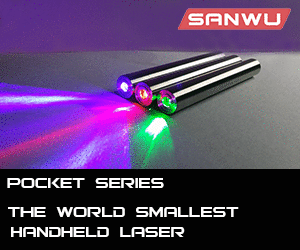I assume the laser in question is a 532nm DPSS (Diode Pumped Solid State).
The flicker you are observing is an example of mode-hopping. DPSS lasers sometimes do that, especially the less-expensive types. It has to do with the alignment and polarization of the crystals, the exact dimensions of the crystals (which will vary with temperature), as well as the exact input (pump) wavelength (which may also vary with the temperature of the pump diode).
The 532nm laser is quite an involved system, much more so than, say, a 650nm or 405nm direct-diode laser. It involves multiple transfers and transitions of energy through the crystal sequence, and any mis-alignment, mal-adjustment, or irregularity at any point therein can cause such effects.
If you use a beam expander (or un-focus the beam with the built in focusing mechanism, if present) you may well observe the beam profile changing, "flickering", or whatnot as the laser operates; this is mode hopping and it's possible with any DPSS laser. The effect is primarily due to thermally-induced changes in the crystal orientation, which in turn affect the gain of the active regions of the resonant cavity.
If all it does is flicker a bit on startup, I would ignore it and just keep the laser. It isn't much of a big deal, especially once you understand that all DPSS lasers are prone to such effects on some level or another. At that point, you can appreciate the fact that the laser is stable overall, once the initial instability has been overcome.
At least, that is how I see it.
Edit: DPSS lasers really do not like cold temperatures. The system works within a definite and somewhat narrow temperature range. Too cold, too hot, and the output will suffer. That is simply the nature of a system whose operation depends on a precise orientation of its components. Changes in temperature change that orientation; too much of a change and the system's efficiency will be affected. Nothing to be done about it other than avoid such adverse conditions.



